Behind the Scenes at the Spring
A beautiful place turned out not to be inaccessible after all
I was an only child in Chicago in the 1970s. At age eleven, I lost my mother to cancer. This experience creates the theme and the background to my writing. My memoir follows a formerly confident young girl suddenly fragile and precarious. With luck and courage, she establishes solid ground through nature, journal writing, and friends of all ages. My Substack entries support my book-writing process. Click the title in your email to be sure to see the whole post.
Back Then: What I Found
The spring, the abandoned mill on the ridge, and the woods were on private property back in 1970. The owners allowed visitors, but there was no sign—you had to know where the turn-out was, a bare spot in the woods just off the road, and slow way down if you didn’t want to miss it.
The path to the spring plunged down from the mill in almost a straight line through the Missouri woods. It was steep—but if you were a marble, you’d bounce off of rock after rock on the way down. The path leveled out at a chain of ledges. Roaring river on the right; rock bluff on the left. Wild sapling trees, ferns and columbine clung to the rocks, damp from the cold spray of the river. The rock bluff itself leaked a slow, clear pool of water from underneath, as if it were a big old piece of sponge, and the path had a puddle.
I must have been very short then, the first time I remember going to the spring with my parents, because something small, in a crevice of a natural rock stairstep, riveted my focus. I squatted down to take it in.
Slim as shoelaces, baby snakes—lots of them—writhed in a tangle under some low grasses, spilling out onto the rock as if they’d just been born.
I’d seen a snake in the woods before, walking with my parents, but I’d never even heard of the wild little scene I’d just spotted. Astonished, I absorbed the sight as if I knew I’d never see such a thing again.
When I swung my head around to look over my shoulder, I heard someone say, “What did she find?” My mom and dad and others—maybe my aunt and Granny—were coming up behind me, not as fleet of foot as I was. I’d gotten ahead.
A gasp. My mom saw what I was looking at. There was a fuss! I think my dad picked me up and carried me past the snakes, and everybody else took a giant step over them. The fuss died down, we walked on, and I savored my treasures: the memory of the nest of baby snakes, plus the ability to spot them on my own and be thrilled.
The path to the spring ends at a final rock ledge, narrow and hard to get to. Beyond that is a cave mouth, in a rock wall, with a river pouring out. This clear-green-blue water is joined by a vigorous spring boiling up from the deep riverbed a quarter mile downstream. All this water flows off through its natural channel in the green forest.
My mom collected some small ferns that day. She wrapped them in a wet cloth and said, “If anybody says anything, this is a diaper. Fran, you’re the baby, OK?” It took me the rest of the walk to the spring and back up the hill to the car to figure out what she meant by that. Probably I was five or six.
I don’t know how many times I went to the spring with my mom—three or four times, maybe?
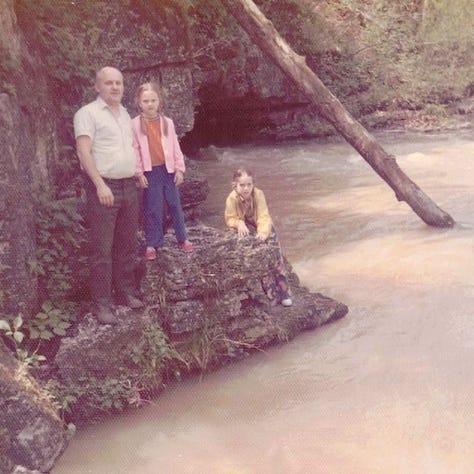
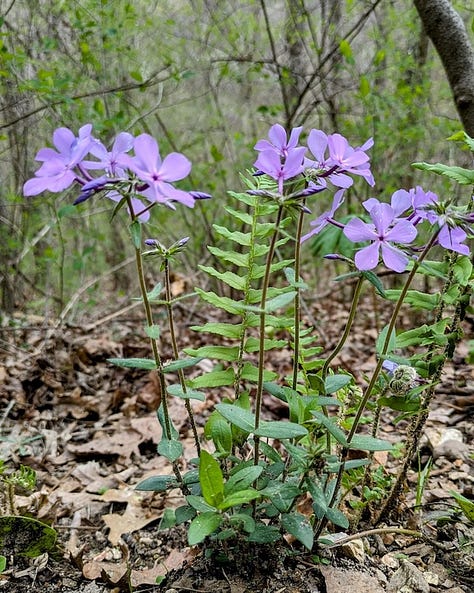
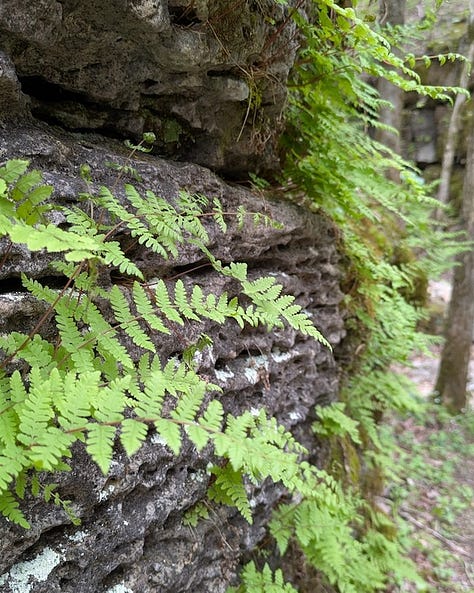
My mom loved the moment when she would start to hear the rushing water, long before seeing it. My aunt loved the vivid blue-green of the water, the shade of clarity that gave it away as springwater even downstream. I loved being in such a hidden place and feeling truly immersed in nature—and every time, I hoped I’d again find a mess of baby snakes.
That my mom and her family knew about the spring was one more thing that made them special. My mom’s family and their Ozarks home, in my eyes, practically glowed in my fascination.
My dad and I went to the spring several months after my mom’s death, when I was twelve, and later I went with my aunt, and later still I took a college friend there (though I don’t know how we didn’t drive right past it, as I don’t think it was signed until the 1990s).
This Month
Today, the spring is part of a national forest, but in a miracle of progress, almost nothing has changed. The road is the same hilly, winding two lanes and no shoulder, surrounded by deciduous forest. The brown sign marking the trailhead is tiny. A more lenient switchback trail was built with seemingly no damage to the forest. Little wood bridges take a hiker across dry or wet ravines on the way down, sparing you the tall weeds in the bottom with the ticks and chiggers. (“Trail”; “hiker”—words I didn’t know in 1970, but I knew what ticks and chiggers were.)
Tom and I were there early this month. We had the spring all to ourselves for more than half an hour before one other party emerged from the foliage.


The Best Part
Also joining the spring, next to the cave mouth and across the river from the end of the trail is a creek as wide as a narrow road, easy to see into (at least in early April), “paved” with scoured-clean bedrock that looks nearly level, “walled” with worn, porous karst. (You can see it in the cave-spring video above or in the pics below.) This creek’s lip of rock lies barely above the surface where the churning river pours from the cave. But, in contrast to the unstoppable, noisy, kinetic froth of the glassy-green river, this creek bed lies silent and still. Saplings grow at the foot of its rock bluffs, but surprisingly little else (at least in early spring, before lanky wildflowers take hold). It looks like a portal into a primordial, untouched Eden.
For as long as I can remember, I’ve gazed into it from the trail as if into a mirage, vivid but out of reach. Here’s the dry-creek portal in 1976, 2019, and 2025.
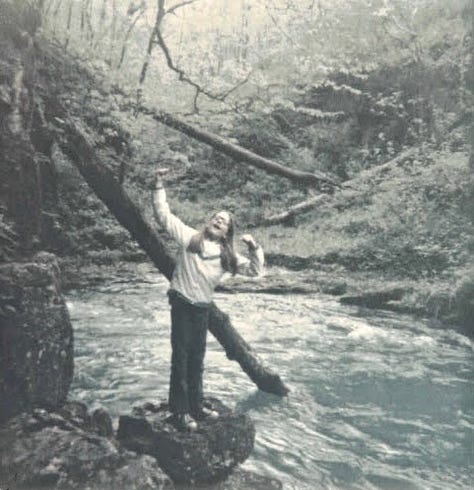
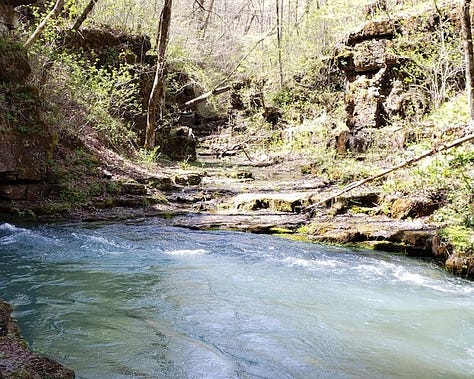
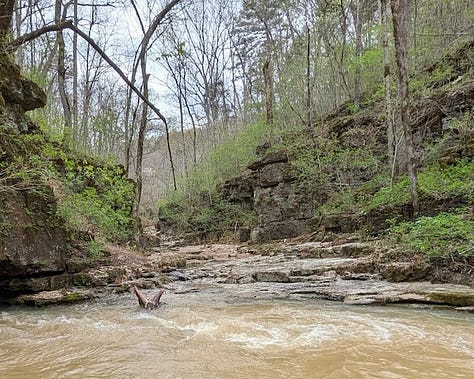
A couple of weeks ago, as Tom and I were about to leave the spring, I said of the dry creek, “It’s the most alluring place and so totally inaccessible.”
Wrong.
Tom looked around to the left of the cave mouth and said, “Is there an unofficial path up the hill? If there is, we could come down on the other side,” into the forbidden streambed.
He was right. Over the hill we went, above the cave and down onto the slabs of bedrock I’d been gazing at for decades. (One of good things about early April is that neither the undergrowth nor the ticks and chiggers are rampant yet. Even three weeks later it’s very different. Timing is part of the reason we’d never yet discovered that hill route.)
I stood on the smooth creek bed and felt that all my dreams of “someday” had arrived. We walked upstream so easily that Tom said, “It’s like a Roman road.” Pools of clear water lay two inches deep in low spots, with no algae or mosquitoes. This was the fresh remains of the flooding storm that swept the region five days earlier.
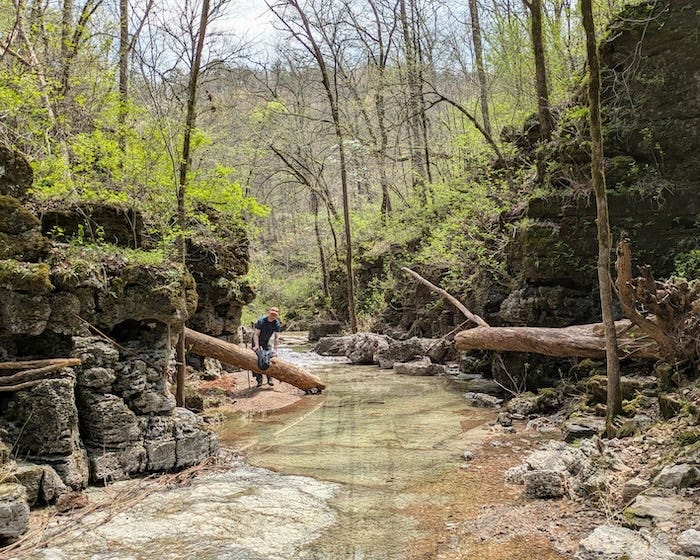
We followed a bend and saw a wall of karst in our road. We easilt climbed on top of it, a six-foot dry waterfall, and looked down into a dry “swimming hole” at its base, full of rocks.
I had wondered if this creek carried water hundreds or thousands of years ago, before the powerful force of water under pressure broke open the cave. But no— this channel would carry surface water, running off the surrounding wooded hills.
And a lot of it. Look at that big downed sycamore tree on the right, and the one Tom is using as a table. Leaf and limb and tree debris was caught, head high on me, trapped behind saplings.
Looking around us at the stranded debris, we could easily imagine the torrent of hard rain pouring down into this “holler,” filling this streambed. It’s a box canyon; a flash-flood path.
So that’s why we’ve never seen it flowing.
If it were possible or sensible to be at the spring during a big storm, we’d see the river rise, first with the deluge coming off the hills, then from the increased volume of the cave spring and the boil. Water would cover the low parts of the trail. A witness would have to be standing uphill, in the woods, to avoid being washed away.
Would we want to drive the winding narrow highway in a storm? Would we want to pick our way down that trail in a hard rain with lightning? Would we want to stand on a steep and muddy path while the river rose? Would we be able to see the flash-flood streambed flow from that vantage point? The river would look like a different place. Maybe this happens a couple of times a year.
I haven’t looked up any of these facts. I might do so. But, like the kid who had the keen eyes for the baby snakes, I love to find things out for myself. Exploring the dry creek above the spring rewarded me with the peace and the natural beauty of the place, the mental exercise of figuring out why it is the way it is, and the gratification of my dream to enter that remote paradise. But I think, even though we know it happens, we will never see that dry creek rushing with water.
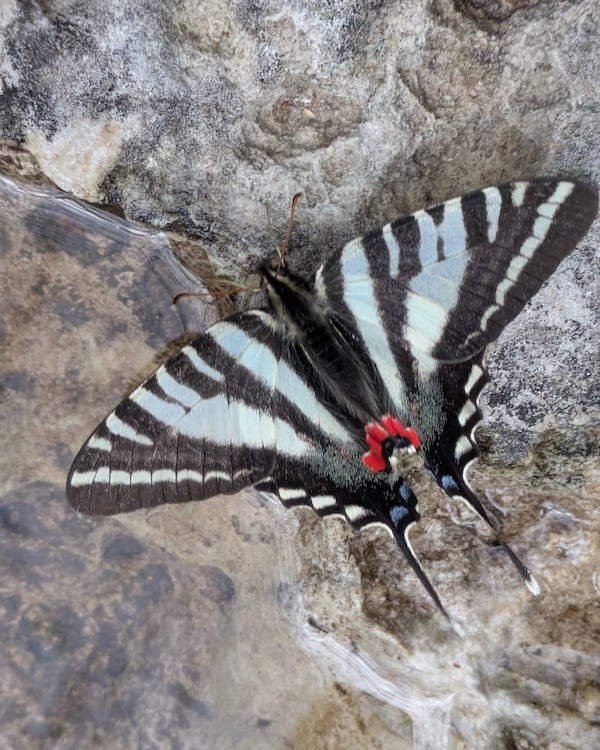


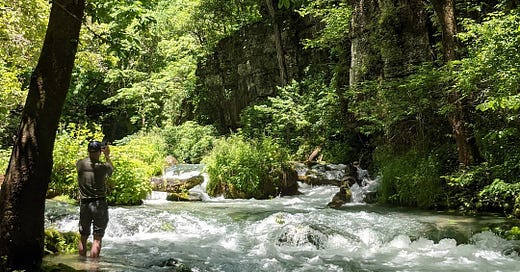



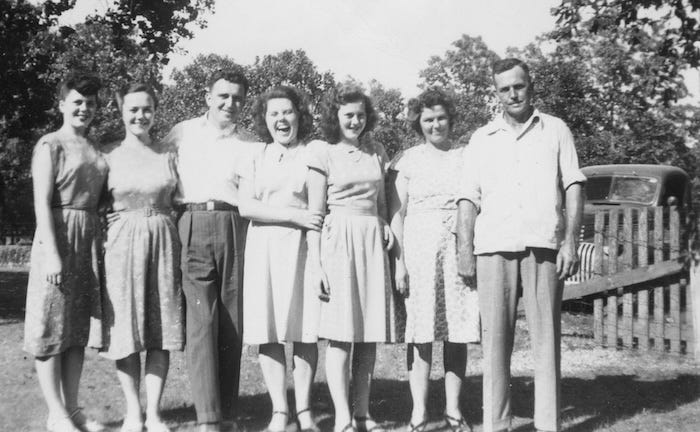
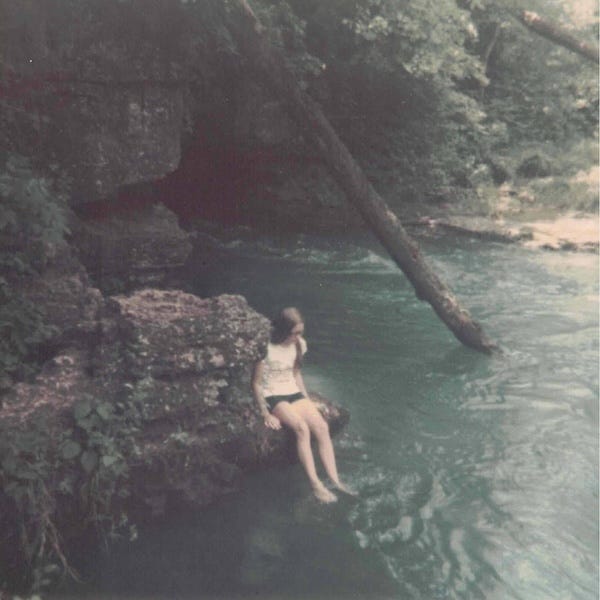
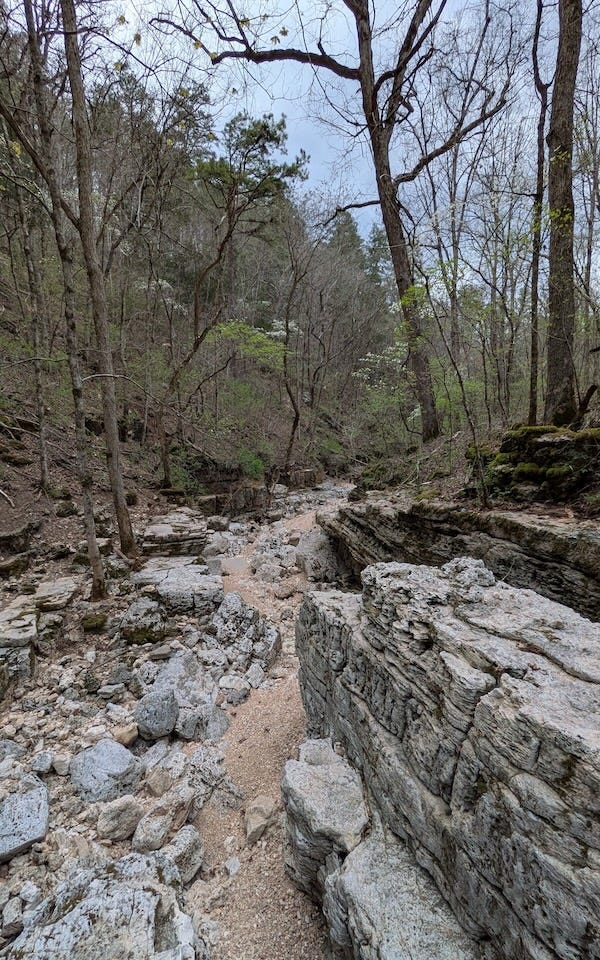
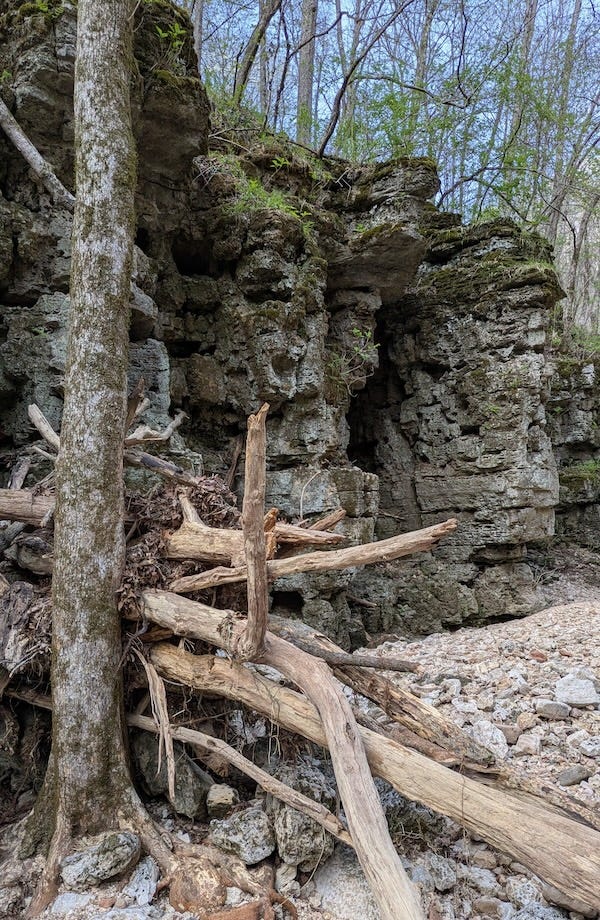
Lovely!
So cool you got to experience that!